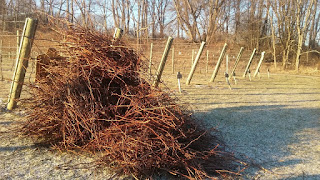 |
| A view across Lake Gervasi, from the foot bridge at the site of the old sawmill. |
It's a surprise to many, but to those of us who work in a vineyard, these darkest, coldest months of the year are the peak of our season.
By the time our vines unfurl their fresh new tentative leaflets, hopefully no sooner than early May, the hardest work of our year will have been completed.
 |
| A Marquette tendril in late May. Marquette is our first variety to break bud in the spring, and our most vigorous grower through the summer. |
So what occupies us these cold, snowy, and / or muddy months, depending on the vagaries of a given season?
 |
Canes from the previous season are carefully cut, measured, weighed, and tallied, to record the vigor of the previous season's vegetative growth.
 |
| Gathering canes to weigh in the North Vineyard. |
We reach out to other growers, state university research specialists across the midwest, and farmers of all types, to compare the details of our seasons, and make our best assessments of what is likely to come.
In our specific viticultural microclimate, winters can be quite varied, and extreme.
 |
| A windswept winter afternoon. |
 |
| Slicing open dormant grape buds to measure the effects of cold temperatures on bud survival. |
We can only measure the effects of our unusually warm early winter by cutting open hundreds of dormant buds gathered from all across the vineyard, and examining them to see if the primary, secondary, and tertiary buds have all survived.
Only then, can we begin the true winter work amongst the vines: our annual dormant pruning.
 |
| Piles of winter prunings on a sunny winter afternoon. |
Because our vineyard site is vulnerable to very cold spring temperature dips and frosts, we follow a double pruning strategy, leaving twice as many fruitful buds on the vines as our crop projections require, in case some of the buds succumb to spring injury.
Once we think we are safely out of the frost period, a second round of pruning must quickly commence, before the rampant green growth of the new season gets too far ahead of us.
But it's not all drudgery and detail work.
 |
| Long shadows across the frozen lake in February. |
And perhaps not least of all, it's a season of mystery, especially once mid-February rolls around, and love begins to stir among the critters with whom we share the landscape.
So yes, these are our peak months.
The height of our season.
For a brief moment in winter, all of the vines are lush, all the clusters perfect and succulent, existing as they do only in our minds.
 |
| Virgin and Child with Grapes, Lucas Cranach the Elder, circa 1537 |
No comments:
Post a Comment